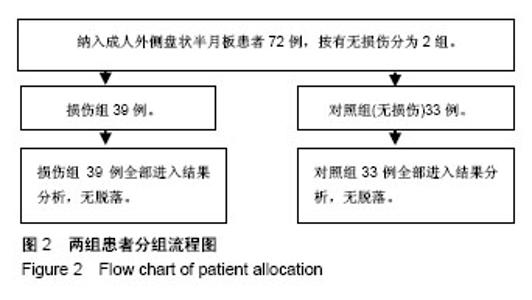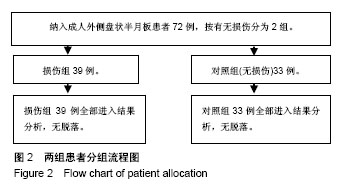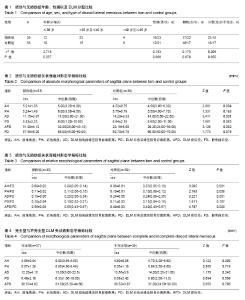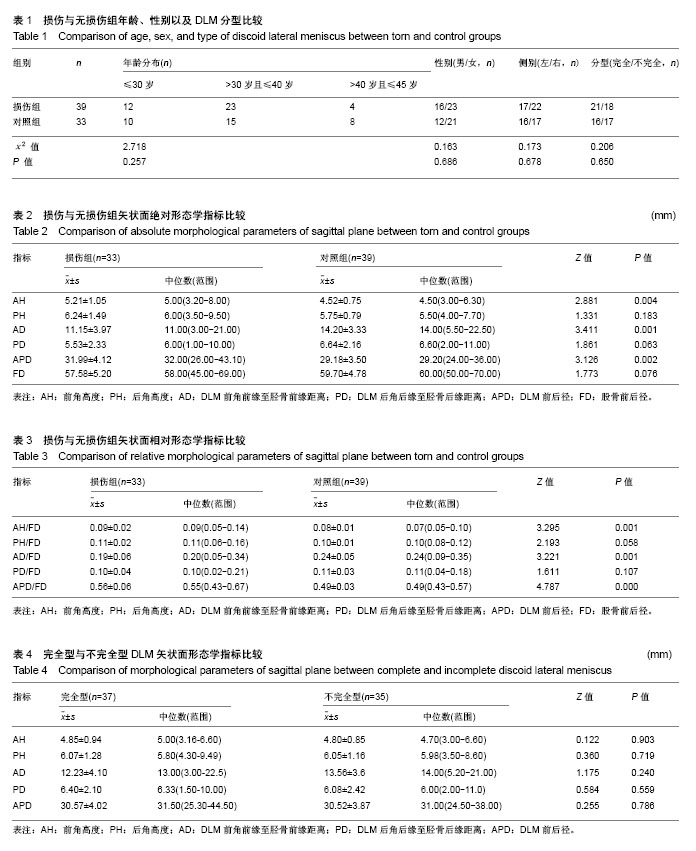| [1] Kim JG, Han SW, Lee DH. Diagnosis and treatment of discoid meniscus. Knee Surg Relat Res. 2016;28(4):255-262. [2] Liu WX , Zhao JZ , Huangfu XQ, et al. Prevalence of bilateral involvement in patients with discoid lateral meniscus : a systematic literature review. Acta Orthop Belg. 2016;12(1): 153-160. [3] Bae JH, Lim HC, Hwang DH, et al. Incidence of bilateral discoid lateral meniscus in an Asian population: an arthroscopic assessment of contralateral knees. Arthroscopy. 2012;28(7):936-941. [4] Atay OA, Pekmezci M, Dorol MN, et al. Discoid meniscus: an ultrastructural study with transmission electron microscopy. Am J Sports Med. 2007;35(3):475-478. [5] Papadopoulos A, Kirkos JM, Kapetanos GS. Histomorphologic study of discoid meniscus. Arthroscopy. 2009;25(3):262-268. [6] 冯锟,周洁,梁治平,等.磁共振成像对膝关节半月板桶柄样撕裂的评估作用[J].实用医学影像杂志,2015,16(4):317-319.[7] Yilgor C , Atay OA , Ergen B, et al. Comparison of magnetic resonance imaging findings with arthroscopic findings in discoid meniscus. Knee Surg Sports Traumatol Arthrosc. 2014;22 (2):268-273. [8] Vaishya R, Vijay V, Vaish A, et al. Double posterior cruciate ligament sign on magnetic resonance imaging: imaging variants, mimics, and clinical implications. J Orthop Case Rep. 2017;7(6):76-79. [9] Watanabe M, Takeda S, Ikeuchi H. Atlas of arthroscopy. Tokyo: Igaku Shoin; 1979:87-91. [10] Choi SH, Ahn JH, Kim KI, et al. Do the radiographic findings of symptomatic discoid lateral meniscus in children differ from normal control subjects? Knee Surg Sports Traumatol Arthrosc. 2015;23(4):1128-1134. [11] Choi SH, Shin KE, Chang MJ. Diagnostic criterion to distinguish between incomplete and complete discoid lateral meniscus on MRI. J Magn Reson Imaging. 2013;38(2): 417-421.[12] 孙晓新,周伟,左淑萍,等.成人完全型外侧盘状半月板损伤的形态学特征及MRI评价[J].中国运动医学杂志,2016,35(9):799-803.[13] 孙晓新,周伟,左淑萍,等.成人外侧盘状半月板损伤的有效影像学指标:MRI影像学评价[J].中国组织工程研究, 2016,20(24): 3535-3540.[14] 孙晓新,余家阔,张柳,等.儿童症状性外侧盘状半月板患者前交叉韧带形态及信号变化的MRI影像学研究[J].中国矫形外科杂志, 2014,22(7):607-612.[15] Ahn JH, Shim JS, Hwang CH, et al. Discoid lateral meniscus in children: clinical manifestations and morphology. Pediatr Orthop. 2001;21(6):812-816. [16] Yoo WJ, Choi IH, Chung CY, et al. Discoid lateral meniscus in children: Limited knee extension and meniscal instability in the posterior segment. J Pediatr Orthop. 2008;28(5):544-548. [17] Ahn JH, Kim KI, Wang JH, et al. Long-term results of arthroscopic reshaping for symptomatic discoid lateral meniscus in children. Arthroscopy. 2015;31(5):867-873. [18] Chedal-Bornu B, Morin V, Saragaglia D. Meniscoplasty for lateral discoid meniscus tears: long-term results of 14 cases. Orthop Traumatol Surg Res. 2015;101(6):699-702. [19] Fields LK, Caldwell PE 3rd. Arthroscopic saucerization and repair of discoid lateral meniscal tear. Arthrosc Tech. 2015; 4(2):185-188. [20] Lee CH, Song IS, Jang SW, et al. Results of arthroscopic partial meniscectomy for lateral discoid meniscus tears associated with new technique. Knee Surg Relat Res. 2013; 25(1):30-35. [21] Dai WL, Zhang H , Zhou AG, et al. Discoid lateral meniscus. J Knee Surg. 2017;30 (9):854-862. [22] Ahn JH , Kang DM , Choi KJ .Risk factors for radiographic progression of osteoarthritis after partial meniscectomy of discoid lateral meniscus tear. Orthop Traumatol Surg Res. 2017;103 (8):1183-1188. [23] Jochymek J, Peterková T. Long-Term outcomes of surgical management of symptomatic fibular discoid meniscus in childhood. Acta Chir Orthop Traumatol Cech. 2015;82(5): 353-357. [24] Kushare I, Klingele K, Samora W. Discoid meniscus: Diagnosis and management. Orthop Clin North Am. 2015; 46(4):533-540. [25] Carter CW, Hoellwarth J, Weiss JM. Clinical outcomes as a function of meniscal stability in the discoid meniscus: a preliminary report. J Pediatr Orthop. 2012;32(1):9-14. [26] Harato K , Niki Y, Nagashima M, et al. Arthroscopic visualization of abnormal movement of discoid lateral meniscus with snapping phenomenon. Arthrosc Tech. 2015; 4(3):235-238. [27] Park HJ, Lee SY, Park NH, et al. Usefulness of meniscal width to transverse diameter ratio on coronal MRI in the diagnosis of incomplete discoid lateral meniscus. Clin Radiol. 2014; 69(4):391-396. [28] Hiroto I, Takayuki F, Ami M, et al. Histological and biological comparisons between complete and incomplete discoid lateral meniscus Connect Tissue Res. 2016 ;57(5):408-416. [29] Bin SI, Kim JC, Kim JM, et al. Correlation between type of discoid lateral menisci and tear pattern. Knee Surg Sports Traumatol Arthrosc. 2002;10(4):218-222. |



